
Zero Energy Homes Project
From an upscale home in the suburbs of Atlanta to a cottage in a South Georgia State Park, solar technologies are being integrated into buildings across the state.
Southface, with support from Georgia Environmental Facilities Authority, the U.S. Department of Energy Zero Energy Home and Building Programs, assisted in the construction of two Solar Energy Homes.
These homes featured advanced solar energy technology, high performance thermal envelope, energy efficient heating and cooling systems and appliances, and green building products.
Westbrook Solar EarthCraft House - Cumming, Georgia
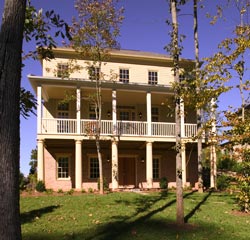
is a three-story, four-bedroom single family home with beautiful double front porches.
The home serves as a model encouraging potential homebuyers to include solar and other resource efficient technologies into their own homes.
The home is 45 percent more energy efficient and will cost approximately $842 less to run each year than a typical new home of the same size.
Below is a list of the home's green features.
Building Materials and Techniques
The types of building materials used affect a home's longevity. The Westbrook Solar EarthCraft House incorporates the use of sustainable building materials and techniques including:
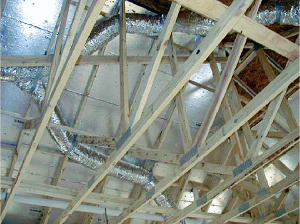

- A radiant barrier (a reflective foil coating on the underside of the roof decking) helps keep the attic cooler during summer months
- Cellulose insulation made from recycled newspaper
- Engineered wood products stretch wood resources, are structurally superior, and can be made from new growth trees
- Advanced framing techniques save lumber while allowing complete coverage of insulation on exterior walls
- Fibrous cement siding made from natural materials is durable and requires little maintenance
- Caulk with low volatile organic compound (VOC) content
Building materials used to increase the home's durability by preventing moisture problems that can lead to mold growth include:
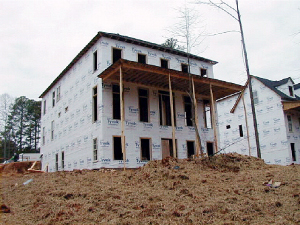

- French drain around exterior perimeter of footer
- Drainage matt installed along exterior of all below-grade foundation walls provides air space for proper water drainage
- Foundation walls covered along the interior with rigid foam insulation to prevent condensation
- Overhangs above all doors
- High efficiency bath fans vented to the exterior
- Kitchen range hood vented to the exterior
- Direct vent water heaters, furnace, and fireplace, vented to the exterior
- Capillary break installed between foundation and framed walls to prevent wicking of water
Air Sealing
A leaky home causes high energy costs, poor comfort, and promotes entry of moisture and contaminants.

Unfortunately many sites for air leakage are hidden from view. The best strategy in both new and existing homes is to reduce air leakage as much as possible and to provide controlled ventilation with fresh outdoor air.
Materials and labor for air sealing the Westbrook Solar EarthCraft House cost approximately $450.
Eliminating gaps in exterior sheathing and interior drywall reduces air leakage from:

Unfortunately many sites for air leakage are hidden from view. The best strategy in both new and existing homes is to reduce air leakage as much as possible and to provide controlled ventilation with fresh outdoor air.
Materials and labor for air sealing the Westbrook Solar EarthCraft House cost approximately $450.
Eliminating gaps in exterior sheathing and interior drywall reduces air leakage from:
- Exterior walls of fireplace chase
- Exterior sheathing under cantilevered framing
- Behind tubs on exterior walls
- Duct chase connections to the attic
- Recessed ceiling lights
- Door and window rough openings
- Penetrations into the band area, interior and exterior sheathings
- Bottom plates between wood framing and concrete foundation or subfloor
Insulation
The Westbrook Solar EarthCraft House features a mix of insulation types to minimize heat transfer through the walls, ceilings and floors. Insulation upgrades to the home cost approximately $1,000 for labor and materials.
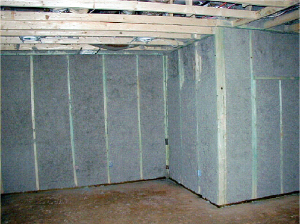

- 50% of the exterior sheathing is R-3 rigid foam board
- R-13 cellulose insulation sprayed into exterior framed walls
- R-8 rigid foam board insulation and R-13 sprayed cellulose insulation on foundation walls
- R-38 loose-fill cellulose ceiling insulation
- R-4 exterior doors
Basement
The Westbrook Solar EarthCraft House demonstrates how to properly seal and insulate a basement to increase comfort, save on energy costs, improve durability, and reduce the entry of moisture, soil gases and other pollutants into the home. The basement features include:
- Foundation drain installed around the perimeter of the footer (rather than on top of the footer) keeps excess water from soaking the footer
- Capillary break installed between foundation and framed walls prevents wicking of water into the wood framing

Drainage matt installed along the exterior of the below grade foundation walls helps maintain an airspace for proper drainage.
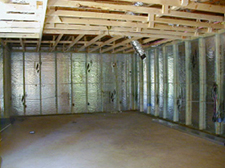
Floor to ceiling foundation wall insulation prevents condensation and maintains a more constant temperature throughout the basement.
Exhaust Ventilation
Ventilation is important to exhaust moisture and odors from baths and kitchens year-round.
- All bath fans are quiet, featuring a low sone ratings of 0.5 sone at 50 cubic feet per minute (cfm) to 3.0 sones at 340 cfm
- Bath fans are vented to the exterior and are wired with the lights so that when the bath light is on, the fan is also on
- Kitchen fan vented to the exterior
Heating, Cooling and Fresh Air Ventilation
On average 41% of a home's energy usage can go to conditioning (heating and cooling) the house. Determining the correct size of heating and cooling equipment is key to achieving comfortable interior conditions -- temperature and humidity -- and saving on the cost to buy and operate equipment. Estimated cost for all HVAC improvements is $2,500.
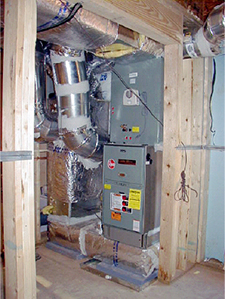
Cooling: 5 tons, 14.25 SEER (the higher the SEER, the more efficient the unit is).
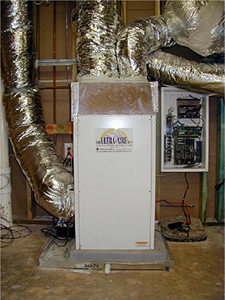
Electronic air filter reusable for life.
- Zoned duct system with a variable speed blower optimizes moisture removal, energy performance and comfort while using only one central heating and cooling unit for the entire home
- Heating: 94% AFUE direct vent natural gas furnace (the higher the AFUE, the more efficient the unit is)
- Fresh air ventilation controlled by a whole house dehumidifier keeps the home drier and occupants more comfortable in summer at higher room temperatures
- UV light air cleaner
- Programmable thermostats allow different temperature settings during the day, evening, and weekend to save energy
- All duct work insulated and connections sealed with mastic reducing duct leakage to less than 5 percent
Home Appliances and Lighting
Lighting and appliances account for more than 45% of all energy bills in a home. Every $1 spent on electricity for an incandescent bulb, provides 10¢ worth of light and 90¢ worth of heat.
The estimated upgrade cost for all lighting improvements in the Westbrook Solar EarthCraft House is $300. No additional costs are added for using energy efficient appliances since they are widely available.
The estimated upgrade cost for all lighting improvements in the Westbrook Solar EarthCraft House is $300. No additional costs are added for using energy efficient appliances since they are widely available.
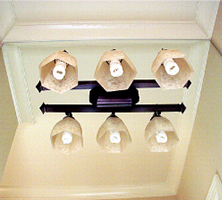 Compact fluorescent light (CFL) fixtures and CFL bulbs in traditional light fixtures replace traditional incandescent lighting and reduce the amount of energy used for lighting by approximately 40%
Compact fluorescent light (CFL) fixtures and CFL bulbs in traditional light fixtures replace traditional incandescent lighting and reduce the amount of energy used for lighting by approximately 40%
Indoor Water Conservation
Atlanta, like many communities, is facing a water crisis. Water efficient fixtures save money, provide high performance and protect the environment.
- Dual flush toilets offer the option of using a 0.8-gallon flush or a 1.6-gallon flush depending on the amount of water needed.
Water Heating
Water heating is typically the third highest energy cost in a home--16% of total energy cost on average. Selecting the appropriate fuel and water heater type, using efficient system design, and reducing hot water consumption can manage water heating energy costs.
- Two direct vent, tankless natural gas water heaters with a total upgrade cost of $1,100
Windows
The Georgia Energy Code encourages that windows and glass doors used have a solar heat gain coefficient (SHGC) less than 0.4 and a U-factor of 0.65 or less. The SHGC is a measure of the amount of solar heat (heat radiating from the sun) that an object blocks. U-factor measures the amount of heat conducted through a material. U-factor is the inverse of the R-value. The lower the U-factor, or the higher the R-value, the more efficient the window.
- All glazing installed in the home is low-E, double paned, wood framed, with a U-factor of 0.35 and a SHGC of 0.34
Photovoltaic System
 Photovoltaic (PV) systems silently generate electricity from free sunlight.
Photovoltaic (PV) systems silently generate electricity from free sunlight.
The Westbrook Solar EarthCraft House demonstrates how PV systems can offset the amount of electric power needed from conventional power plants to improve air quality and reliability.
- The cost for the installed PV system was approximately $13,000
- A 2 kilowatt (kW) grid connected PV system is expected to supply 30% of the home's electricity needs and offset carbon dioxide emissions by 9,039 pounds each year.
